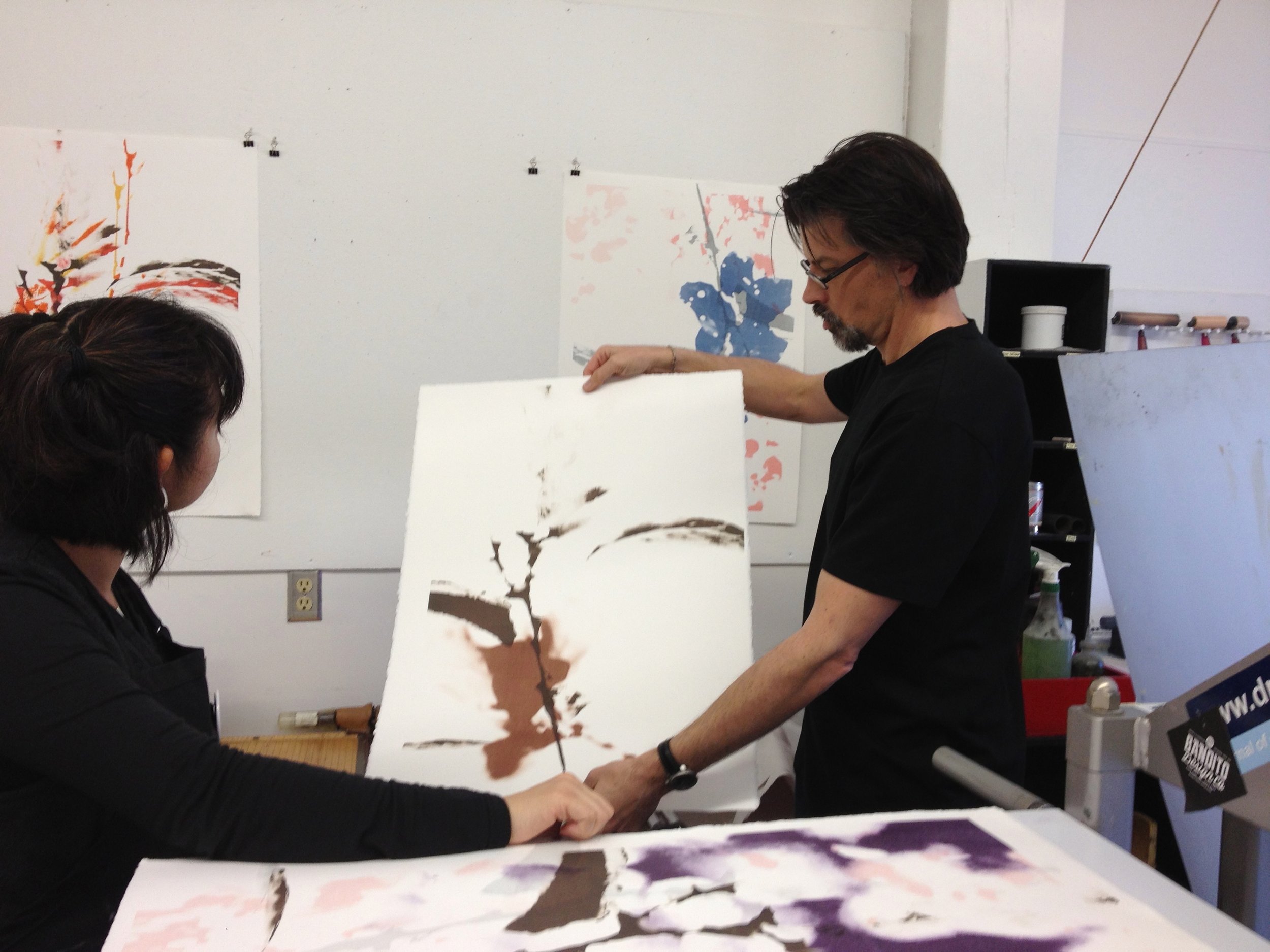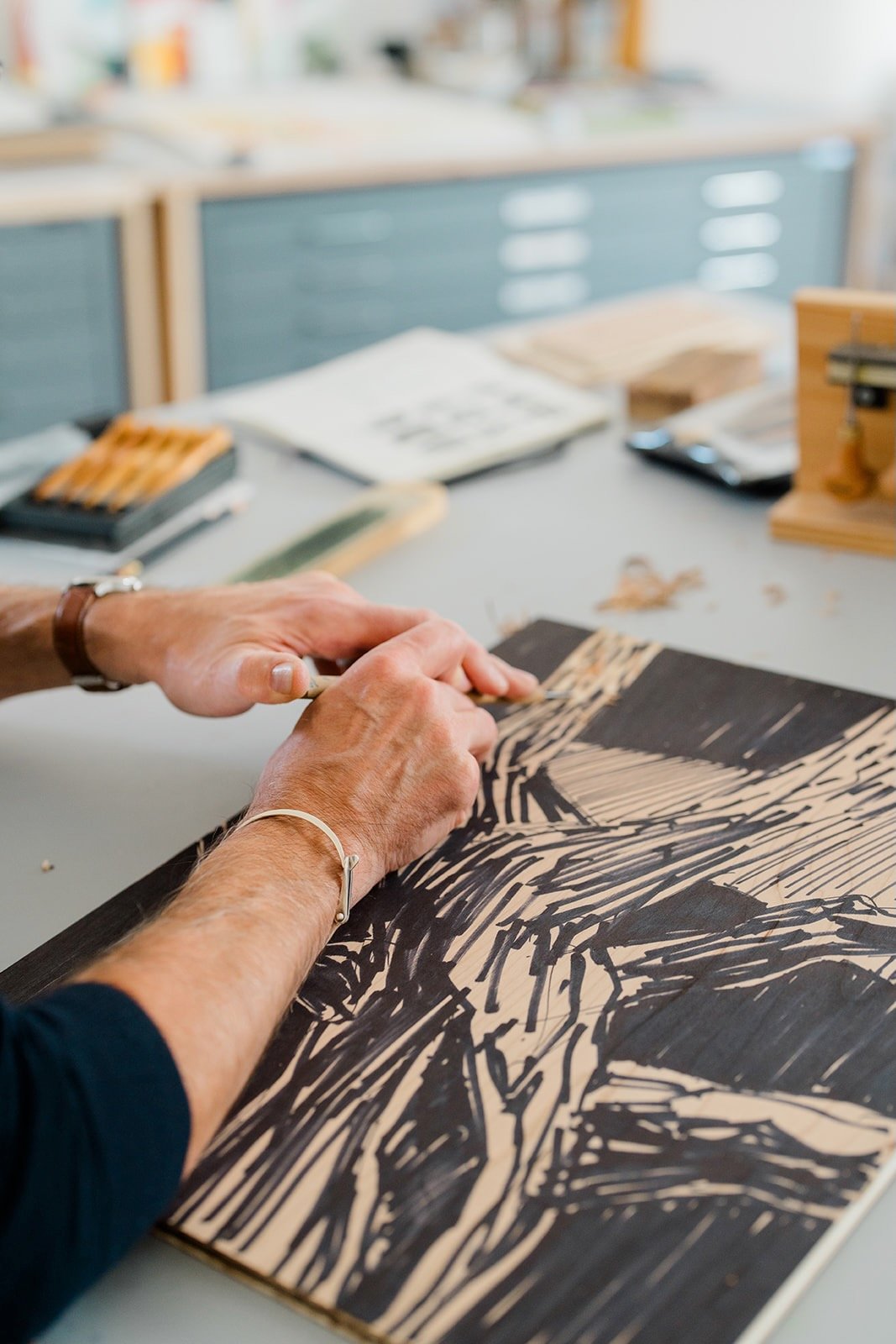A Painter Makes Prints, The Old Fashioned Way
by Michael Rich
Michael carving a woodblock in his studio at 3 Gable
In my last semester at the Rhode Island School of Design, I found a room in my schedule to add a lithography class with the great printmaker, Andrew Raftery. I instantly fell in love with the process. Lithography, making prints from drawings on Flintstone-like slabs of limestone, felt decidedly old-school. The drawing part, working with waxy crayons, was familiar enough but the process involved was not. There was the grinding of the stone by hand and the printing on a press powered only by a hand crank. The delicate process of inking the stone and wiping it down with water to resist the ink, often required working with a partner, someone with “clean hands”. I loved all of it, the old machines, the smell of ink and the shop banter that reminded me of my time on carpentry crews.
It was quite a few years later before I found my way back into a proper printshop. As a Visiting Artist at the Savannah College of Art and Design, I was invited to make a print series in their facilities. Again, I would be working in lithograph. With the help of a wonderful team of students, I was able to transfer photos I took of my plants in my grandmother’s garden to litho plates. Then, we would ink the plates in a variety of colors and mix and match them in layers on the same prints in a process called monoprinting. Rather than creating an edition of prints, all exactly the same, monoprinting yields a series of related prints, no two alike. This way of working was a huge awakening for me to the possibilities of printmaking. I could explore endless variations on a theme by playing with color, changing the order of the layers of the print or even the orientation of the plates. It is still my favorite way to work. I’ve since made intaglio and woodcut monoprint series where I’ve continued to explore the process and my ideas around the natural world in Art.
Michael Printing at The Savannah College of Art and Design in 2013 with Master Printer, Eun Lee
Monoprints underway at the Savannah College of Art and Design Print Studio with Elmer Ramos and Eun Lee, 2013
While there are some artists that only make prints, there’s a long history of painters who also made prints as part of their practice. The Modernist painters in particular, Robert Motherwell, Richard Diebenkorn, Joan Mitchell are all favorites of mine. Helen Frankenthaler revolutionized the contemporary woodcut in color and scale using the Japanese process of Ukiyo-e, a style of printing popular from the seventeenth to the nineteenth centuries. Since I’m making more woodcuts these days, I’ve been looking at the collaged woodcuts of Anselm Kiefer for their expression and scale. To me, the idea that an artist can reach into and explore other media with a level of mastery says something about the depths of their creativity.
Carving a plate - a drawing in Sharpie serves as a rough guide
One I got hooked, I couldn’t stop. I bought a beautiful, Takach press, named her Lucy and here at 3 Gables Studios, have set her up in a small printshop in the basement. I got right to work on a commissioned print series shortly after we moved in. Thinking graphically in print stretches my creative brain. There are so many differences from painting - that the printed image will be reversed from the plate is the most obvious. In woodcut, you are working in the negative, in other words, carving away what you don’t want to print, leaving the plate alone on the places you do want printed. Printmaking asks you to think several steps ahead to envision your ideas and to troubleshoot when the prints, as they always do, turn out differently than you thought they might.
Carving a recent block
The medium also changes the character of my work. In paint, I can be loose, drippy and improvisational but in woodcut there are hard edges and strong contrasts. I look long and hard at other artists to better understand the language of tone, edges and space needed to orchestrate a woodcut print. One of my favorites, the Japanese-Canadian printmaker, Naoko Matsubara, who worked in a spontaneous and direct way in her woodcuts. My earliest influence however, might be prints made by my uncle, the architect, Bill Rich, whose woodcuts hung in our house growing up and hang in my print studio now. They are expressive renditions of docks and boats found in Georgetown where he was working at the time, cool and modern with a sixties vibe. I’ve never tired of looking at them.
Naoko Matsubara, Yanagi, 1982, woodcut, 31 x 22" in
The print shop - my uncle Bill’s woodcut on the wall
As an abstract painter, I work with color, in layers of loose and vague forms that are reminiscent of light and color in the landscape. Woodcut, however, is more of a commitment to an image. I don’t know why it happens but I am drawn to depicting elements of the natural world, leaves, branches, plants and nests in a stylized but recognizable way. I really enjoy playing with these shapes that feel like I am acquiring a new a different visual language for myself.
I almost feel like a different artist.
One way that I have found to subvert this, is to use the prints as raw material for collage, tearing them and combining them in ways that feel as improvisational as painting. I am constantly learning something new about how to carve and how to print successfully. Somehow, I think this makes me a better painter.
Uliveto (Olive Grove), Pictured above, is a limited edition of 3 prints.








